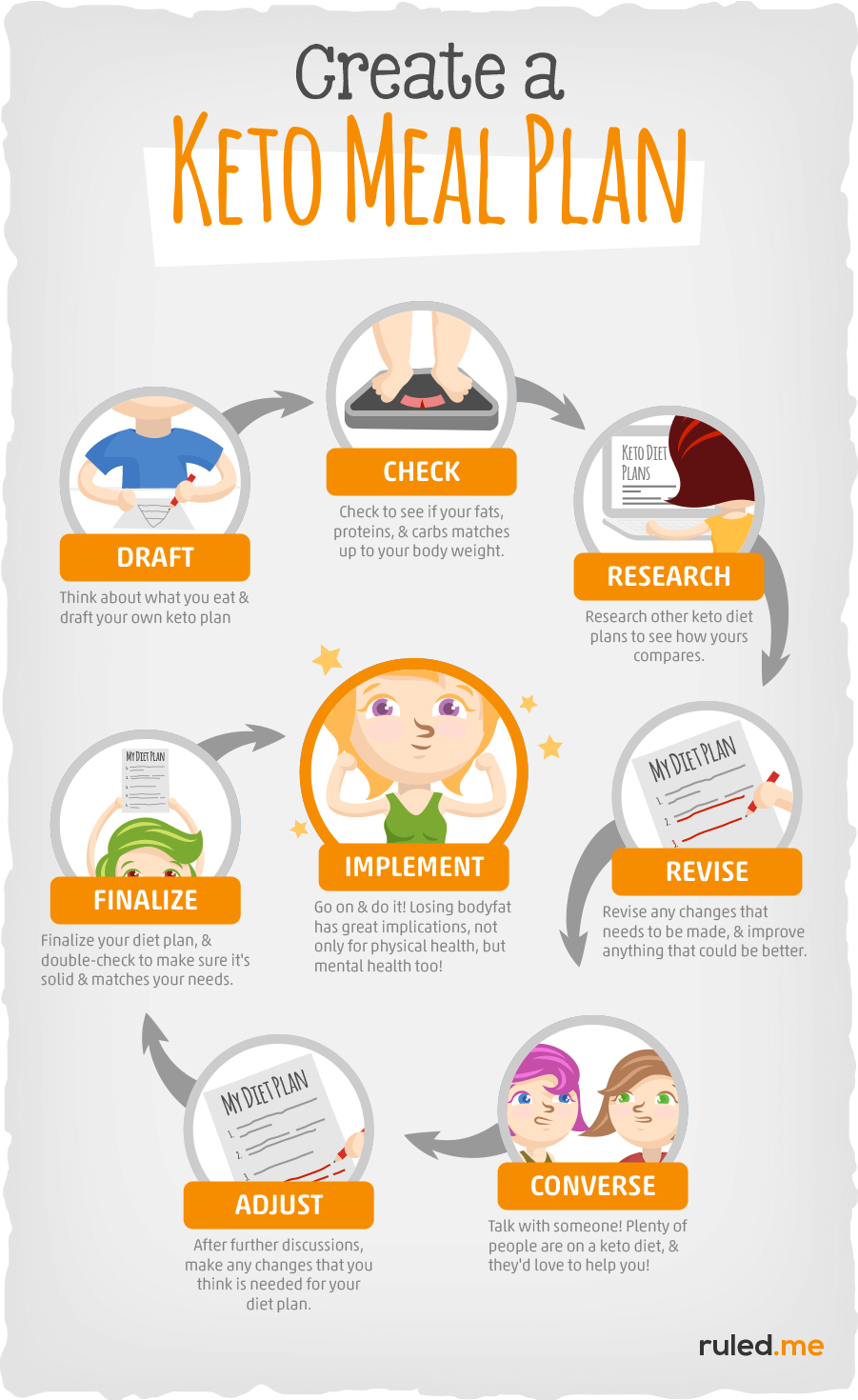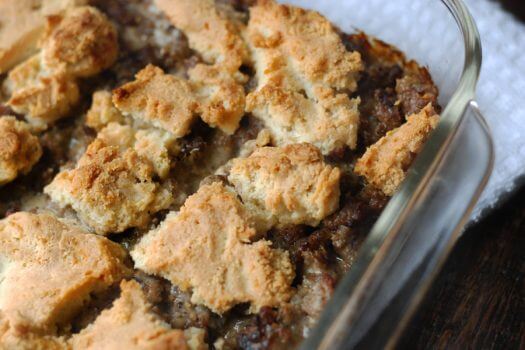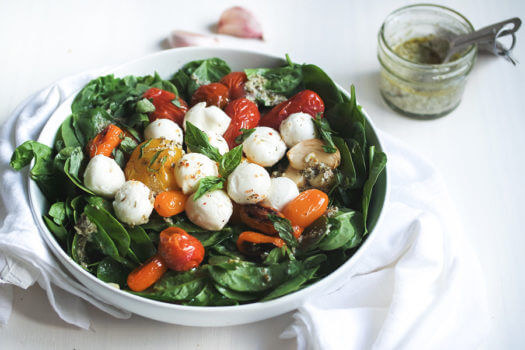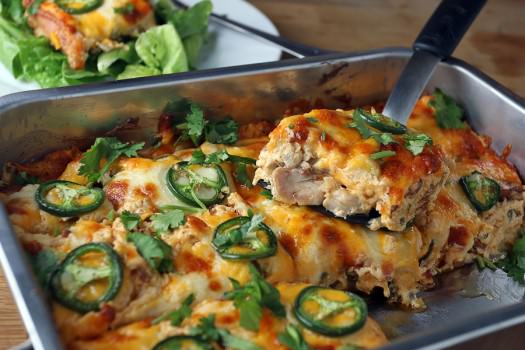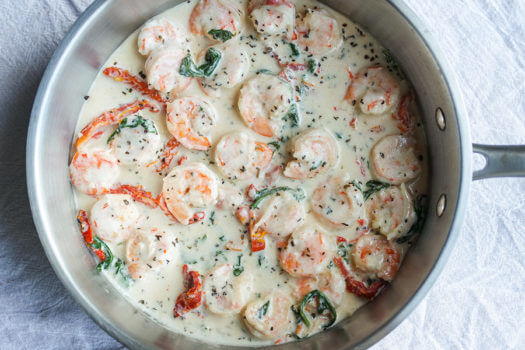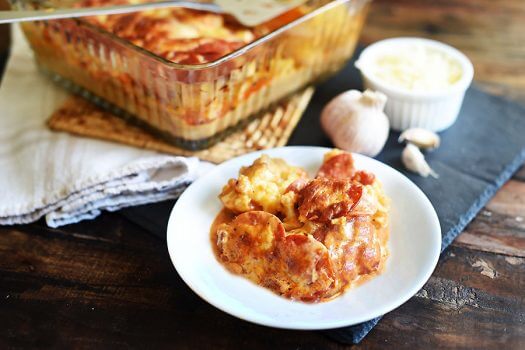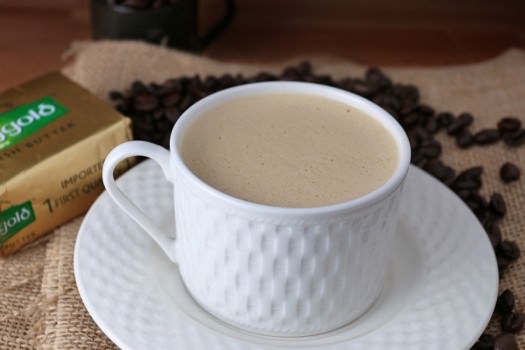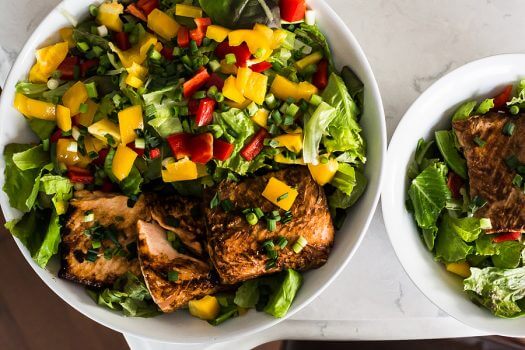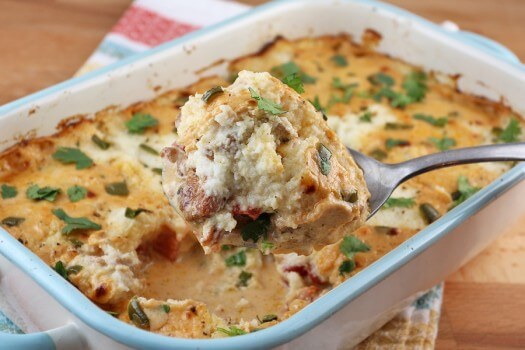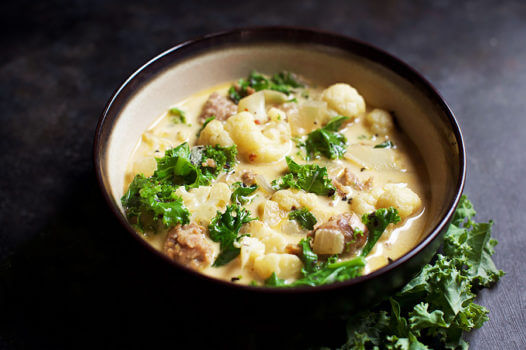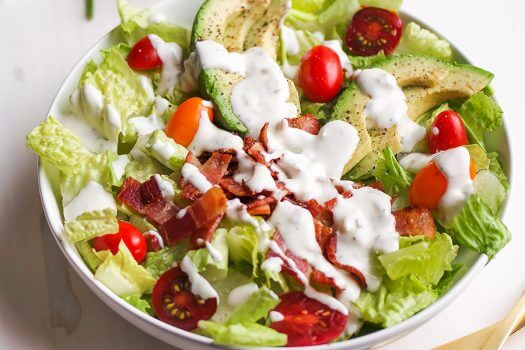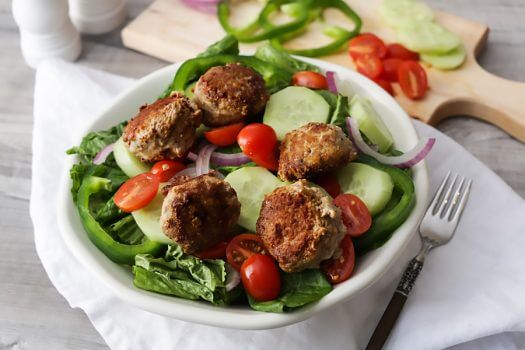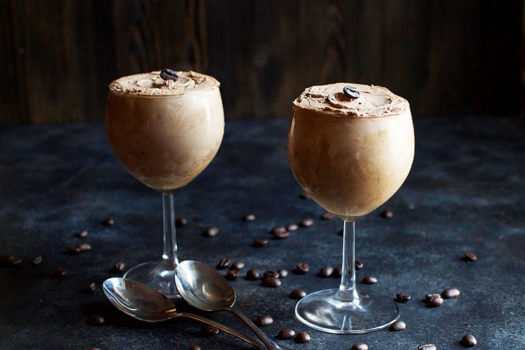In the past few years, the ketogenic diet has become one of the most popular lifestyles of weight loss and improved health worldwide. If you’ve been looking for a way to kick off a change in your eating habits, this meal plan will lay out a foundation that you can follow along with.
The downloadable and printable keto diet meal plan features tried and true recipes that you’ll be sure to enjoy. From make-ahead meals, using leftovers, cooking low-carb treats, to incorporating intermittent fasting – this meal plan will show you the different aspects of keto from all angles.
You’ll find over 15 delicious recipes in the meal plan – breakfast, lunch, and dinner every day (except when fasting) along with dessert. Perfect for starting out and seeing a bit of variety in a standard ketogenic diet.
In this article, we’ll go over the basics of keto, from what it is, what to eat, to a full 14-day plan you can follow yourself to see what it’s all about. If you want to skip ahead, feel free to use the links below:
- What is Keto (and How Does It Work)?
- What Foods to Eat
- Premium Meal Plan for Your Macros
- Tips Before Starting
- Preview of Week 1
- Preview of Week 2
- Get the Plan
- Inside the Shopping List
- FAQ & Resources
What is Keto and How Does it Work?
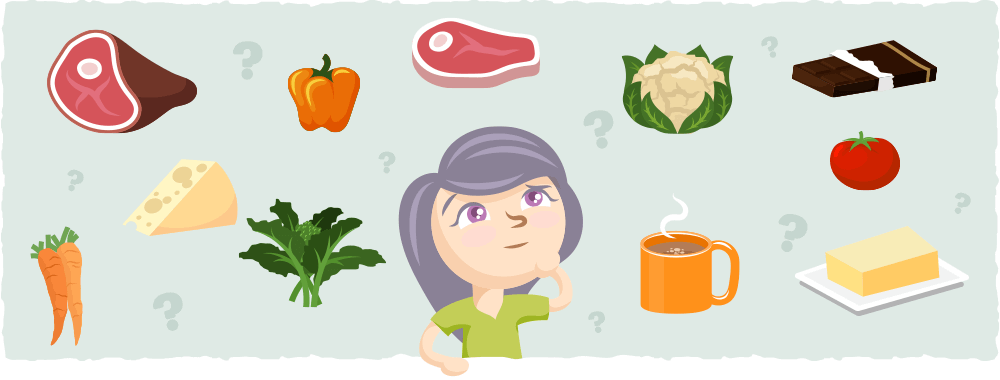
A keto diet is well-known for being a low carb diet, in which the body produces ketones in the liver to be used as energy. It’s referred to by many different names – ketogenic diet, low carb diet, low carb high fat (LCHF), and so on. Though some of these other “names” have different nutritional standards, we’ll stick with the rules of keto.
When you eat something high in carbs, your body will produce glucose and insulin. Glucose is the easiest molecule for your body to convert and use as energy so that it will be chosen over any other energy source. Insulin is produced to process the glucose in your bloodstream, by taking it around the body. Since the glucose is being used as a primary energy, your fats are not needed and are therefore stored.
By lowering the intake of carbs, the body is induced into a state known as ketosis. This allows your body to use the fat you’re eating along with your body fat to create energy called ketones. Instead of using glucose for energy, you now use fat. While this is a basic explanation of how keto works, if you want more information please read through our in-depth guide to ketosis >
Why start a ketogenic diet meal plan? Some researchers swear that it is the best diet for most people to be on, while others think it is just another fad diet. While there isn’t one perfect diet for everyone or every condition, there is plenty of solid research backing up the benefits of keto. In fact, it has been found to be better than most diets at helping people with:
- Weight Loss & Obesity
- Epilepsy
- Type 1 & 2 Diabetes
- High Blood Pressure
- High Blood Sugar Levels
- Heart Disease
- Polycystic Ovary Syndrome (PCOS)
- Cancer
What Foods to Eat on Keto?
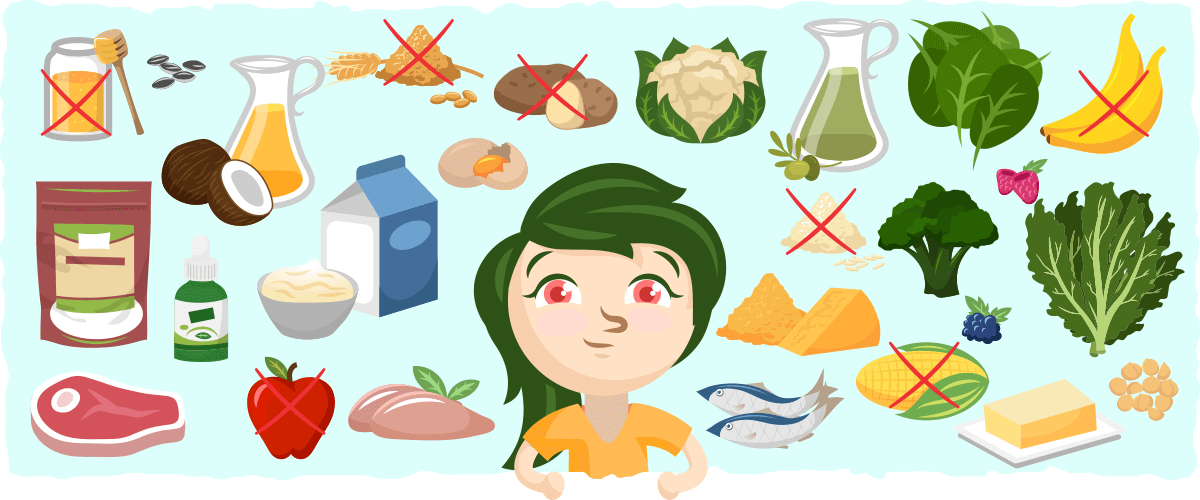
Being on a diet isn’t the easiest thing in the world, especially when you don’t know what you should eat. Below is a quick list of what to eat and what to avoid, but if you want a more in-depth approach on everything you should and shouldn’t eat, check out our ketogenic diet food list >
You want to keep your carbohydrates limited, coming mostly from vegetables, nuts, and dairy. Don’t eat any refined carbohydrates such as wheat (bread, pasta, cereals), starch (potatoes, beans, legumes) or fruit. The small exceptions to this are avocado, star fruit, and berries which can be consumed in moderation.
Do Not Eat
- Grains – wheat, corn, rice, cereal, bread, etc.
- Sugar – honey, agave, maple syrup, corn syrup, etc.
- Large Fruit – apples, bananas, oranges, grapefruit, etc.
- Tubers – potato, yams, etc.
Do Eat
- Meats – fish, beef, lamb, poultry, eggs, etc.
- Leafy Greens – spinach, lettuce, swiss chard, kale, etc. (fresh or frozen)
- Above ground vegetables – cabbage, asparagus, broccoli, cauliflower, zucchini, etc. (fresh or frozen)
- High Fat Dairy – hard and soft cheeses, high fat cream, butter, etc.
- Nuts and seeds – macadamias, walnuts, pecans, almonds, sunflower seeds, etc.
- Avocado and berries – raspberries, blackberries, strawberries, and other low glycemic impact berries
- Sweeteners – stevia, erythritol, monk fruit, and other low-carb sweeteners >
- Other fats – coconut oil, olive oil, MCT oil, high-fat salad dressing, saturated fats, etc.
Here’s a quick video that goes over the full 14-day keto meal plan and what you can expect. The video is condensed into just a few minutes, so keep in mind all of these keto meals are 2 weeks worth. Scroll down to learn more about it and download it to try out yourself!
Get Personalized Meal Plans Made for You
If you’re looking for a simple, long-term solution, the Keto Academy may be right for you. Our program will allow you to create customized keto meal plans made specifically to your macros. This will scale over 1,300 recipes down to your specific macros and let you choose (or swap out) recipes as you want.
It’s simple: you choose the recipes you like and they will always be made to your exact macros. No guesswork and no tracking needed.
You can specify exactly how much time you have to cook, if you want to avoid any foods, and if you want to use leftovers as well. You get full control over what you eat and you just need to follow along with the plan. If you enjoy intermittent fasting for a boost of weight loss, you can also enable that. A shopping list is made and will adapt to any recipe you swap out. You can scale the meal plan for multiple people, too!
Tips Before Starting Your Meal Plan
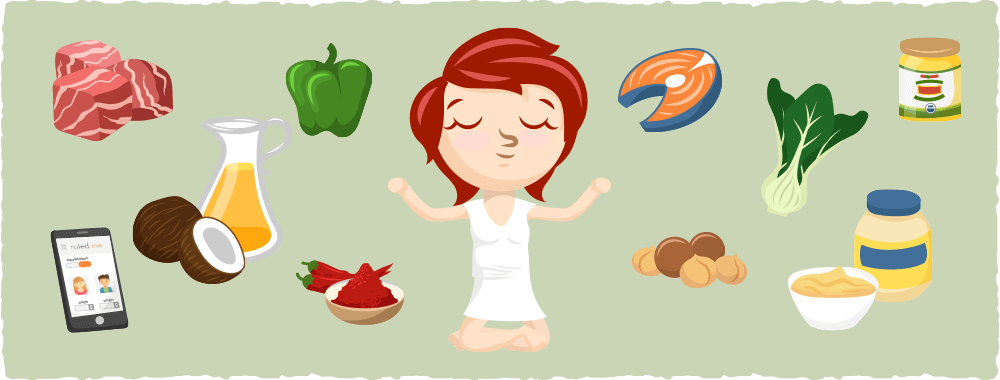
1. Calculate Your Macros and Adjust Plan
Calories are still something you need to consider on a ketogenic diet. While some people can get away with the “eat until full” philosophy, this doesn’t work for most people. There are tons of hormone, endocrine, and deficiency problems that we still need to take into account.
Use our keto calculator to figure out exactly how much you need to eat and adjust the plan to fit your needs. This meal plan averages 1538 calories, 120g fat, 24g net carbs, and 83g protein over the 2 weeks. If this is different to your macros, consider adjusting the plan to fit your needs.
To increase calories. If you need to increase the fat intake of the plan, add additional oil, cream, cheese, or cream cheese into your recipes; or drink coffee with cream with your first meal. If you need to increase protein, just increase the amount of lean meat that’s added into the recipe.
To decrease calories. If you need to decrease the fat intake of the plan, remove oil, cream, cheese, or cream cheese from the plan. Similarly, if you need to decrease the protein intake of the plan, remove some lean meat that’s added to the recipes.
2. Prepare and Get Ready Ahead of Time
You want to keep your cheats to none. Be prepared, make sure you’re eating what you need in order to be satiated, and make sure you’re satisfied with what you’re eating. If you have to force yourself to eat something, it will never work out in the end. This is just a guideline on how you can eat on a ketogenic diet, so you’re very welcome to change up what kind of foods you eat!
Set a start date. Be realistic with yourself and set a date you want to start. Make sure to get the shopping ready for when you start so that there’s no missing ingredients or surprises. Commit yourself to follow the plan fully and stick to the start date you determine.
Re-organize your fridge and pantry. With temptation looming each time you open the cupboard, it can be difficult to stick to your newfound dietary choices. Ketosis is a process that happens in your body. You can’t just have “that one” cheat meal. If you do, it can hamper progress for up to a week before your body is back in ketosis and burning fat again.
If possible, clear out any high-carb snacks and tempting items from your kitchen so that you can stay on track. There will likely be a few new keto ingredients you’ll need to purchase for the plan, so make sure you read ahead and stock up your fridge as needed.
3. Understand the Keto Flu
The Keto Flu is a combination of symptoms that happen when you first transition to a low-carb way of eating. You may get dizziness, headache, fatigue, cramping, nausea, or fatigue for a few days after starting your keto meal plan. Don’t worry, this is normal and there are ways to combat it.
Keto is also a diuretic and can cause dehydration. With the extra urination, you will deplete both water in your body and your electrolytes quicker. Your T3 (thyroid hormone) will decrease some, and your cortisol levels will raise up. Although the keto flu affects everyone differently, you may feel some of these symptoms but you can do something to reduce the symptoms or completely stop them.
Simply increase your water intake (or drink other keto-friendly beverages) and increase your electrolytes. You can use electrolyte supplements (this is the one we use) or take a multivitamin that includes potassium and magnesium. Additionally, add salt to your food (and/or water) to help.
If you want to get a deeper look into the keto flu and more tips on how to remedy it, take a look at our in-depth article here >
4. Stop Mindless Snacking
Not only does snacking increase the number of calories you’re intaking per day, but it also creates insulin spikes each time you eat a small meal. It’s truly best to cut out all snacking when you’re on keto to see the best results. Keeping snacks to a minimum will allow your body to use your fat stores as energy and allow you to see success.
Last but not least, just do it. It’s fantastic to read, research, and plan but at the end of the day you just have to jump in and make sure that you start. Good luck!
Week 1 of the Keto Diet Meal Plan
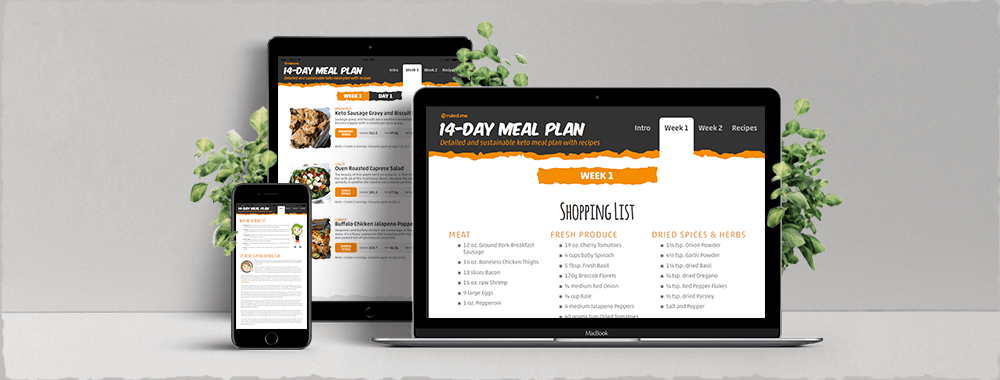
Our main goal here is to stay pretty simple at first. In my eyes, simplicity is key for someone that is just starting out on a low carb diet. You don’t want it to be a difficult transition (kitchen-wise) because it will be hard just to get rid of your cravings in the beginning. You don’t want to spend too much time cooking and slaving away to make meals.
Leftovers will be another thing we will take into consideration. Not only is it easier on you, but why put yourself through the hassle to cook the same food more than once? Breakfast is something I normally do leftover style, where I don’t have to worry about it in the morning, and I certainly don’t have to stress about it. Grab some food out the fridge, pre-made for me, and head out the door. It doesn’t get much easier than that, does it?
Breakfast.
For breakfast, you want to do something that’s pretty quick and tasty, and of course – gives you some leftovers. I suggest starting day one on the weekend. This way, you can make something that will last you for the entire week (or close to it). The first week is all about simplicity with flavor. Nobody wants to be making breakfast before work, and we’re not going to be doing that either! We’ll focus on making flavorful breakfasts that you can either make in a pinch or have leftovers for the week.
There’s a variety of low-carb options so that you can have an idea of a generic week on a ketogenic diet. If you want to add more variety, feel free to browse our breakfast recipes for more ideas. You can replace any of the breakfasts in the plan with recipes of similar nutrition.
Lunch.
We’re also going to keep it simple here. We’re mostly relying on salads that you can make the night before if needed. You can portion out the salad and dressing/components separately beforehand and grab-and-go in the morning.
The salads will be mostly a bit of protein with leafy greens. This helps with our micronutrient intake and will help tremendously with fat intake while keeping it low-carb. You can also add spices and seasonings to your salad to your liking. Just be careful about onion and garlic powder, but most other spices in small amounts have negligible carbs.
Dinner.
Dinner will mostly be casseroles with cooked-in vegetables, so no side dishes required. Casseroles are great on a low-carb, ketogenic diet because you get so many leftovers. It’s not uncommon to see recipes that take quite a long time to make, so when you can save a little time by eating leftovers, it makes a world of difference. Simply stick them in the fridge, reheat as needed, and you have dinner in little to no time at all.
Sides and snacks.
As a general rule of thumb, it’s best to keep snacking to a minimum in order to keep insulin spikes to a minimum.
P.S. No dessert for the first week. Studies show that cravings will be significantly reduced when you skip out on sweetened items for a while.
Week 1 Weekly Macro Averages
| CALORIES | FATS (g) | CARBS (g) | FIBER (g) | NET CARBS (g) | PROTEIN (g) | |
| Day 1 | 1570.2 | 123.1 | 31.1 | 12.1 | 19.6 | 85.2 |
| Day 2 | 1360.7 | 105.9 | 31.4 | 8 | 23.4 | 63.1 |
| Day 3 | 1570.2 | 123.1 | 31.3 | 12.1 | 19.6 | 85.2 |
| Day 4 | 1493.8 | 125.8 | 31.8 | 9 | 22.9 | 66.4 |
| Day 5 | 1651 | 134.1 | 24.5 | 7.3 | 17.6 | 91.3 |
| Day 6 | 1442.7 | 106.4 | 29.3 | 7.5 | 21.9 | 83.3 |
| Day 7 | 1584.3 | 138.8 | 38.2 | 12.8 | 25.9 | 58.8 |
| WEEK TOTALS | 10672.7 | 857.1 | 217.7 | 68.7 | 151 | 533.4 |
| DAILY AVERAGE | 1524.7 | 122.4 | 31.1 | 9.8 | 21.6 | 76.2 |
Recipes Included in Week 1
It’s important to note that we do use meat and dairy in our recipes. The bulk of the meal plan is based on an average ketogenic diet that most people would follow. If you don’t eat meat, you can still do keto but it will be a bit more challenging. You will rely on plant-based protein and added fats to get to your goal macros. You can see some examples of our vegetarian and vegan keto recipes at the end of this article!
Week 2 of the Keto Diet Meal Plan
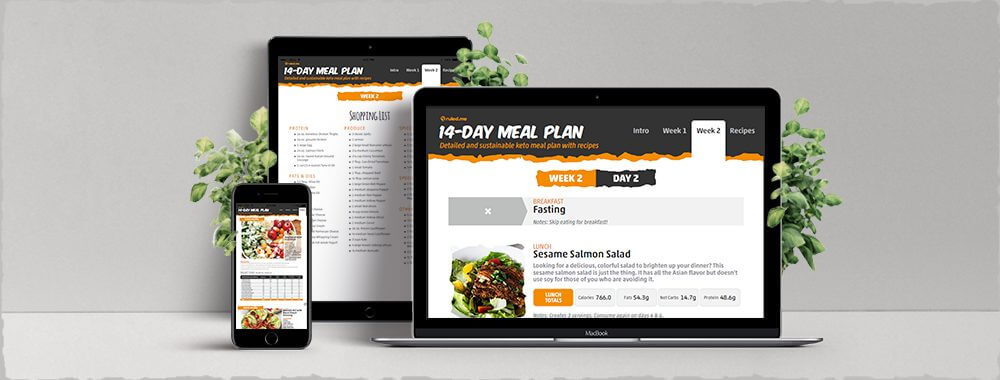
This week we’re going to be keeping it pretty simple again. After finishing off the leftovers, we’ll incorporate intermittent fasting. We’ll also include some desserts to keep your sweet tooth at bay. I’ll introduce you to some of our favorite classic low-carb recipes including new salads, soups, and another casserole.
Breakfast.
We’re fasting! Black coffee if you’re a caffeine addict like me. Tea, if you are not into the coffee so much. Tea can add great health benefits like coffee also. Some of the great benefits of green tea are:
- Polyphenols – These function as antioxidants in your body. The most powerful antioxidant in green tea is Epigallocatechin gallate (EGCG), which has shown to be effective against fatigue.
- Improved Brain Function – Not only does green tea contain caffeine, but it also contains L-theanine, which is an amino acid. L-theanine increases your GABA activity, which improves anxiety, dopamine, and alpha waves.
- Increased Metabolic Rate – Green tea has been shown to improve your metabolic rate. In combination with the caffeine, this can lead up to 15% increased fat oxidization.
Make sure to drink plenty of water throughout the fasting (and through the day). It’s very important to stay well hydrated on keto – I recommend at least 2.5 liters for women and 3.5 liters for men.
Lunch.
Easy to prep salads with lots of leftovers. We’ll alternate between a salmon salad and a meatball bowl. Plenty of leafy greens and protein to fill you up and fantastic to break a fast with. Green vegetables and high-fat dressings (or vinaigrettes) are key. Making sure to balance out the fats with the amounts of protein is very important.
Dinner.
Dinner will be pretty simplistic. We alternate between a soup and a casserole that taste great and develop even more flavor as you use them up as leftovers. On the last day, we’ll have a second salad to give you a bit more variety and a better idea of what type of foods you should be eating on a keto meal plan.
Dessert is included for a few days – if you don’t like coffee with chocolate, just leave the coffee out of the dessert!
Week 2 Weekly Macro Averages
| CALORIES | FATS (g) | CARBS (g) | FIBER (g) | NET CARBS (g) | PROTEIN (g) | |
| Day 1 | 1531.5 | 119.4 | 26 | 8.7 | 17.5 | 90.8 |
| Day 2 | 1645.5 | 127.7 | 43.2 | 11.5 | 31.7 | 85.2 |
| Day 3 | 1502.3 | 110.4 | 35 | 10.4 | 24.6 | 101 |
| Day 4 | 1645.5 | 127.7 | 43.2 | 11.5 | 31.7 | 85.2 |
| Day 5 | 1502.3 | 110.4 | 35 | 10.4 | 24.6 | 101 |
| Day 6 | 1645.5 | 127.7 | 43.2 | 11.5 | 31.7 | 85.2 |
| Day 7 | 1385.1 | 104.5 | 37.8 | 12.6 | 25.1 | 82.1 |
| WEEK TOTALS | 10857.8 | 827.6 | 263.4 | 76.6 | 187 | 630.6 |
| DAILY AVERAGE | 1551.1 | 118.2 | 37.6 | 10.9 | 26.7 | 90.1 |
Recipes Included in Week 2
Download Ketogenic Diet Meal Plan
Since this is my full-time job, donations really help allow me to post as much to the website as I do. It’s not often that someone can say “I love my job” and mean it, but this is one that I’m truly able to. I just want to say thank YOU for making that possible. While I do really appreciate any donation you want to give, you can enter $0 in the amount given to download it for free! I’ve added $10 as the suggested price. I think that’s a very fair price considering other websites are charging in the hundreds of dollars and I’ve seen what they are like on the inside.
I have put a lot of work into this and revised it many times, but if you want it for $5 or $10 or $0, feel free to put whatever you want in the amount – I have no hard feelings! You can always download it for free and if you agree that the quality is worth paying for, come back and give a small donation to help me keep doing what I’m doing.
Shopping List for Your Plan
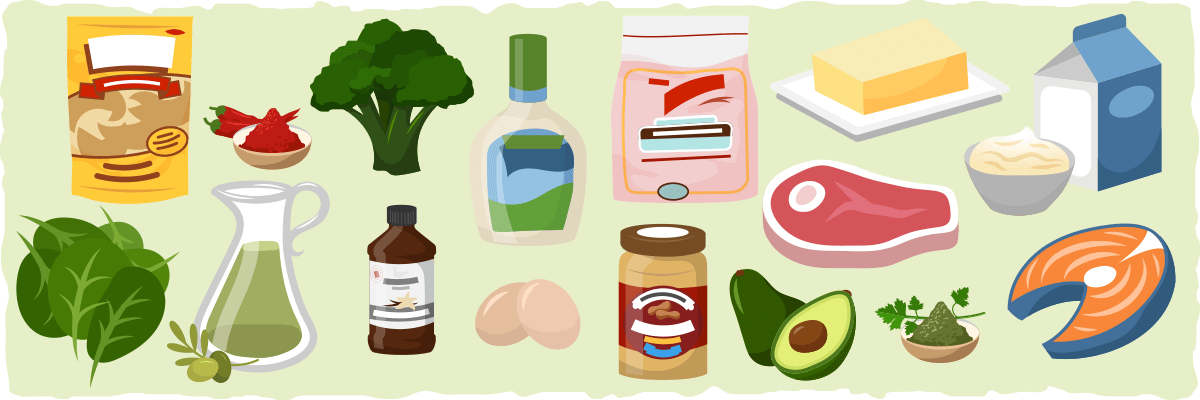
At the beginning of each week, you’ll get a shopping list to use to get all of the groceries you need for your keto meal plan. The shopping list is broken down into categories
- Protein
- Fats & Oils
- Produce
- Dairy
- Spices & Herbs
- Specialty Baking Items
- Other
Feel free to look through the shopping list and adjust to your needs. You may already have some of the spices and baking items in your home. You can usually cut back on cost as well if you are on a budget. Swap out different types of cheeses for 1 type of cheese; use an all-purpose seasoning instead of multiple different seasonings; use 1 type of vinegar instead of multiple.
To save a bit more money, you can usually combine some produce items as well. Instead of getting multi-colored peppers, stick to green. Instead of using fresh herbs, you can use dried herbs which are typically cheaper. If there are multiple types of lettuce, you can usually just get 1 type (spring mix is a favorite of mine for dark leafy greens).
FAQ & More Resources
Once you’ve followed through with the meal plan, you should have a good foundation on where to start and either create your own meal plan, or use a meal planning tool like our Keto Academy. Here are some of the most common questions we get and a few extra resources to help you stay on track:
How can I increase or decrease the calorie amounts in the plan?
If you find that’s you’re too hungry after eating the food, or not hungry enough, then you will likely need to adjust the plan to fit your body and activity level. Make sure to use our keto calculator to find your recommended set of macros.
Using those macros, you can adjust the plan as needed:
- To increase fat: Add additional oil, cream, cheese, or cream cheese to your plan. You can add slightly more vegetables into the plan (and use the additional fat to cook them) as well.
- To increase protein: With any lean meat in the plan, adjust the amount used until your needed protein levels are reached. Try to only increase the use of lean meat as fattier meats will significantly increase the calories as well.
- To decrease fat: Use less added oil, butter, cream, or cheese in a recipe until you get to your needed fat amount.
- To decrease protein: Reduce the use of lean meat in the plan. As an example, if the recipe calls for 8 oz. of shrimp, use 6 oz. instead. Adjust as needed until you get to your protein requirements.
I don’t like a recipe in the plan. Can I use a different one?
Of course! We have a library of over 700 keto recipes on the website. You can swap out any meal that has similar macros, or build upon a meal to get to the needed macros for that specific meal. While not every recipe is a complete meal, you can add low-carb vegetables in to supplement your micronutrient intake.
Can I snack while on this keto plan?
It’s best to not snack while following this plan. Your meals should satiate you and keep you full between the meals. Make sure that you’re drinking plenty of water and staying hydrated (and supplementing with electrolytes if needed).
If you find that you’re regularly hungry on the plan, you should consider checking your macros and adjusting the plan to fit your macros. Snacking will spike your insulin level and you want to have as few insulin spikes as possible while following the plan.
That said, it’s inevitable that some snacking may happen. If that do decide to grab a snack, you should be prepared for if it. We have some great examples of keto snacks to use during your progress.
I don’t eat dairy/nightshades/[insert excluded food]. Can I still use this meal plan?
You can still follow keto if you want to avoid certain foods or have allergies to certain foods. Make sure to search the website (or visit our full FAQ) for more information.
When cutting out dairy, it has shown to improve weight loss and typically help people get past a stall if they encounter while following their meal plan. This guide to dairy-free keto will help you cut out dairy and give some replacement ideas (+ a sample meal plan).
Can I drink alcohol on keto with this plan?
You can drink alcohol on keto, but you have to be mindful of the impact on macros it will have. Usually, every shot of liquor will contain ~100 calories (with no nutrition). If you are a frequent or heavy drinker, this will be very impactful on your overall calorie consumption.
Another thing to keep in mind is that alcohol does slow overall weight loss progress down. That said, it’s expected to have an occasional drink, and if you’d like some ideas you can read our guide to keto and alcohol >
I’m vegetarian/vegan, can I still follow this keto diet plan?
While it can be difficult, going vegetarian or vegan on keto is possible. Whether you’re doing it for improved health benefits, environmental concerns, or ethical reasons we have a few guides that should help.
- If you want to do vegetarian keto, this guide will help break down what you can and can’t eat alongside give some suggestions on meal ideas.
- If you’re wanting to go vegan keto, this guide will give you an overall scope of what to eat and a sample meal plan.
If you have any other questions or just want to learn more about keto in general, check out our other keto diet blog posts or make sure to visit our Full Keto FAQ List >
Create Your Own Keto Diet Plan!
You can use my meal plan as a guideline to help you create something that fits into your life and schedule. Keep in mind that hitting (or at least coming close to) your daily macros is the most important thing when it comes to your success. Modify or edit recipes as needed to make them fit within your macros.
You should usually never go above a 25% calorie deficit (to lose weight) or 15% surplus (to gain muscle). Use the keto calculator on the website to determine your macros as a starting point!
